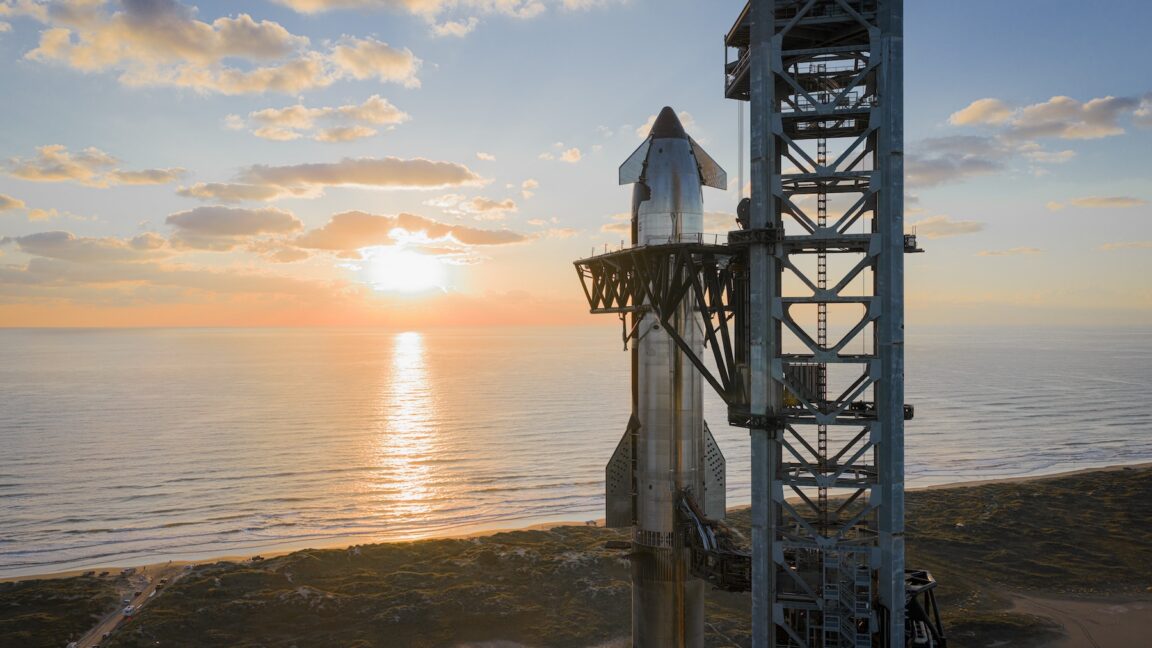Science
SpaceX Launches Starship’s 11th Test Flight, Aims for Success

SpaceX successfully launched the 11th full-scale test flight of its Starship rocket on Monday evening, marking a significant milestone in the company’s efforts to refine its spacecraft. The launch took place at 18:15 CDT (19:15 EDT; 23:15 UTC) from South Texas, with the rocket aiming for a one-hour journey that will conclude in the Indian Ocean. This test flight represents the culmination of a challenging year for SpaceX and is designed to enhance the capabilities of the Starship program.
Preparations for the launch began with the loading of over 10.5 million pounds of super-cold methane and liquid oxygen into the rocket approximately an hour before liftoff. SpaceX’s control team, stationed a few miles from the launch pad at Starbase, Texas, oversaw the countdown and performed critical checks on the vehicle’s systems. The Super Heavy booster, equipped with 33 Raptor engines, generated an impressive 16.7 million pounds of thrust, surpassing the power of the Soviet N1 rocket, which is the second-largest rocket in history.
This flight marks a notable occasion as it is the second time SpaceX has utilized a previously flown Super Heavy booster, which successfully launched and landed during a test flight in March. Although the flight trajectory will resemble that of the previous Starship mission in August, it incorporates new testing protocols for enhanced performance. The booster will separate from the Starship upper stage approximately 2.5 minutes into the flight, with the upper stage igniting its engines to continue its ascent into space.
The test flight includes a critical evaluation of the booster’s landing capabilities. SpaceX has modified the landing burn engine sequence to a new “13-5-3” configuration, employing a combination of engines to improve resilience against potential engine failures. This change aims to gather valuable data on vehicle dynamics as the engines shut down during different phases of the flight.
In a strategic shift, the booster will not return to Starbase for recovery but will instead target a controlled splashdown in the Gulf of Mexico. Following the booster separation, the Starship upper stage will deploy eight Starlink satellite simulators, which will follow a similar suborbital path before disintegrating upon reentry over the Indian Ocean.
The emphasis on testing the heat shield is crucial for this flight, especially given that prior Starship missions faced challenges during reentry. After successfully completing a launch and reentry in August, engineers identified issues with the heat shield’s design. For this flight, SpaceX intentionally removed tiles from specific locations on Starship to stress-test vulnerable areas, seeking to enhance the vehicle’s capacity to withstand the extreme temperatures of 2,600° Fahrenheit (1,430° Celsius) during reentry.
The long-term objective for SpaceX is to enable rapid reuse of Starship without the need for extensive refurbishment. Although several Starship vehicles have survived reentry, none have done so in the condition necessary for immediate reuse. Future flights are expected to culminate in recoveries at Starbase, where the company aims to replicate the successful recovery of the Super Heavy booster.
Looking ahead, this test flight marks the end of the current generation of Starship, as SpaceX prepares for the debut of Starship Version 3 in early 2026. The new version will feature upgraded Raptor engines and larger propellant tanks, along with the capability for in-orbit refueling. SpaceX has secured contracts worth over $4 billion with NASA to develop a lunar lander based on Starship, which will play a pivotal role in the Artemis program.
In anticipation of a higher flight rate next year, SpaceX is actively developing its second launch pad at Starbase and expanding its facilities. The upcoming Starship Version 3 will be designed for improved operational efficiency, allowing for more frequent launches that are essential for fulfilling NASA’s lunar mission goals. The demonstration of in-orbit refueling remains a critical challenge for the program, with the first test expected to occur within the next year.
As SpaceX continues to push the boundaries of space exploration, the outcomes of this flight will contribute valuable insights and advancements toward achieving its ambitious objectives in the coming years.
-

 Science3 months ago
Science3 months agoToyoake City Proposes Daily Two-Hour Smartphone Use Limit
-

 Health4 months ago
Health4 months agoB.C. Review Reveals Urgent Need for Rare-Disease Drug Reforms
-

 Top Stories4 months ago
Top Stories4 months agoPedestrian Fatally Injured in Esquimalt Collision on August 14
-

 Technology3 months ago
Technology3 months agoDark Adventure Game “Bye Sweet Carole” Set for October Release
-

 World3 months ago
World3 months agoJimmy Lai’s Defense Challenges Charges Under National Security Law
-

 Lifestyle4 months ago
Lifestyle4 months agoVictoria’s Pop-Up Shop Shines Light on B.C.’s Wolf Cull
-

 Technology3 months ago
Technology3 months agoKonami Revives Iconic Metal Gear Solid Delta Ahead of Release
-

 Technology3 months ago
Technology3 months agoApple Expands Self-Service Repair Program to Canada
-

 Technology3 months ago
Technology3 months agoSnapmaker U1 Color 3D Printer Redefines Speed and Sustainability
-

 Technology3 months ago
Technology3 months agoAION Folding Knife: Redefining EDC Design with Premium Materials
-

 Technology4 months ago
Technology4 months agoSolve Today’s Wordle Challenge: Hints and Answer for August 19
-

 Business4 months ago
Business4 months agoGordon Murray Automotive Unveils S1 LM and Le Mans GTR at Monterey









